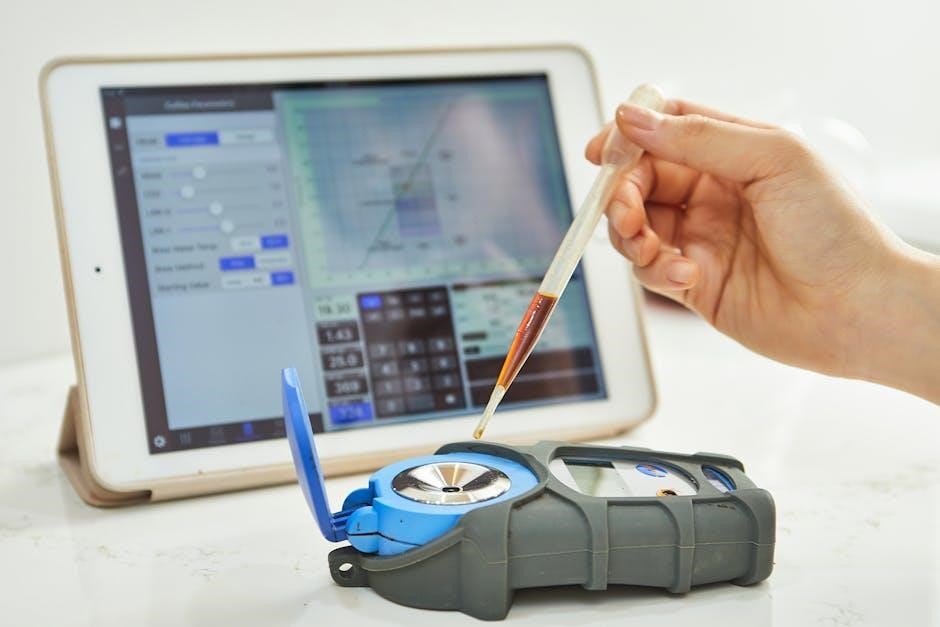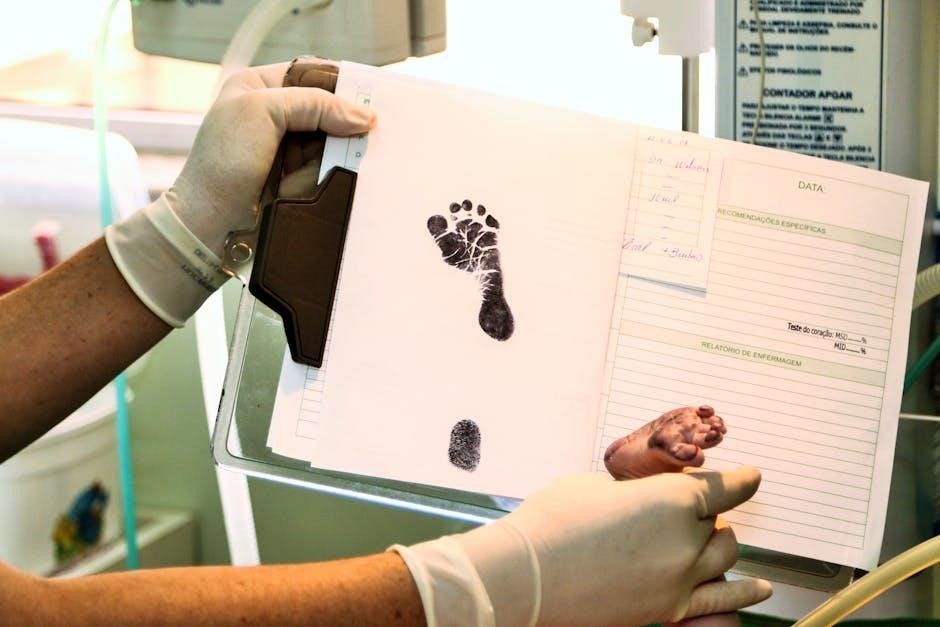The First Data FD130 Terminal is a versatile and user-friendly payment processing solution designed for businesses. It offers ease of use, robust security features, and efficient transaction handling. The user manual provides essential guidance for optimal functionality and troubleshooting.
1.1 Overview of Features and Capabilities
The First Data FD130 Terminal is a cutting-edge payment processing solution designed to meet the needs of modern businesses. It supports EMV chip cards, NFC contactless payments, and traditional magstripe transactions, ensuring compatibility with various payment methods. The terminal features a vibrant color touchscreen, providing an intuitive user interface for seamless navigation. With built-in WiFi and Ethernet connectivity options, it offers flexible setup possibilities to suit different business environments. Enhanced security features, including encryption and tokenization, protect sensitive customer data. The FD130 also includes a built-in thermal printer for fast receipt printing, reducing wait times for customers. Additionally, it supports tip adjustment functionality, making it ideal for service-based industries. The terminal’s robust design ensures durability, while its energy-efficient operation minimizes power consumption. These features combine to create a reliable, efficient, and secure payment processing solution for businesses of all sizes.
1.2 Importance of the User Manual
The user manual for the First Data FD130 Terminal is an essential resource for understanding and maximizing the terminal’s functionality. It provides detailed instructions for installation, configuration, and daily operations, ensuring users can navigate the device confidently. The manual covers troubleshooting common issues, security best practices, and advanced features, making it a comprehensive guide for resolving problems and optimizing performance. By following the manual, users can ensure compliance with security standards, maintain efficient transaction processing, and minimize downtime. Additionally, the manual serves as a quick reference for learning shortcuts and customizing settings to suit specific business needs. Regularly consulting the manual helps users stay informed about updates and new features, ensuring they get the most out of their terminal. Its clear, step-by-step guidance is invaluable for both new and experienced users, making it a critical tool for seamless operation and maintenance of the FD130 Terminal.

Unboxing and Physical Setup
The First Data FD130 Terminal comes with a thermal paper roll, power cable, privacy shield, and AC/DC adapter. Connect peripheral devices like the FD35 PIN pad using shielded cables for optimal performance.
2.1 What’s in the Box?
The First Data FD130 Terminal package includes essential components for immediate setup. Inside the box, you’ll find the FD130 terminal itself, a thermal paper roll for printing receipts, a power cable, and an AC/DC power adapter. Additionally, a privacy shield is provided to enhance security during transactions. For connectivity, the terminal supports optional peripheral devices like the FD35 PIN pad, which can be connected using shielded cables for optimal performance. These accessories ensure a seamless and secure payment processing experience. The contents are thoughtfully packaged to help merchants quickly and efficiently begin accepting card payments. The terminal’s compact design and included accessories make it easy to integrate into various business environments. Always verify that all items are present and undamaged upon unboxing to ensure proper functionality.
2.2 Connecting Peripheral Devices
Connecting peripheral devices to the First Data FD130 Terminal is straightforward and enhances its functionality. Commonly connected devices include the FD35 PIN pad, card readers, and printers. Use shielded signal cables to connect I/O devices, ensuring optimal performance and reducing interference. The terminal’s underside provides ports for optional peripherals, such as additional card readers or PIN pads. Before connecting, ensure all devices are compatible with the FD130 Terminal. Plug in the devices securely, following the user manual’s specific instructions. After connecting, power on the terminal and test each peripheral to confirm proper functionality. For troubleshooting, refer to the user manual or the Quick Reference Guide. Properly connected peripherals ensure seamless transactions and enhanced security. Always verify compatibility and follow the manufacturer’s guidelines to avoid connectivity issues.

Initial Configuration and Setup
The First Data FD130 Terminal’s initial setup involves configuring WiFi settings and establishing a secure password. Follow the user manual for step-by-step guidance on connecting and securing your terminal effectively.
3.1 WiFi Setup Instructions
To set up WiFi on the First Data FD130 Terminal, access the settings menu by selecting the orange toolbar at the top right corner. Choose your network from the list, ensuring WPA2-AES encryption is selected for security. Enter the WiFi password carefully to avoid errors. If issues arise, such as the network not being detected, restart the terminal or check if WiFi is enabled. Refer to the troubleshooting section for further assistance if needed. This process ensures a secure and reliable connection for processing transactions efficiently. Always verify the network name and password to prevent connection failures and maintain optimal functionality. Follow these steps to establish a stable internet connection for your terminal. This setup is crucial for enabling online transactions and ensuring data security. Proper WiFi configuration is essential for the terminal’s performance and reliability in daily operations. By adhering to these instructions, you can successfully connect your FD130 Terminal to your network. This will allow you to process transactions seamlessly and maintain a secure connection. Ensure all steps are followed accurately to avoid any connectivity issues. A stable WiFi connection is vital for the smooth operation of the terminal.
3.2 Password Setup and Security
Setting up a strong password is essential for securing your First Data FD130 Terminal. During initial configuration, create a unique password that combines letters, numbers, and symbols to ensure maximum security. Avoid using default passwords, as they can be easily compromised. Once the password is set, it will be required for accessing the terminal’s settings and performing sensitive operations. Regularly update your password to maintain security. The terminal also supports encryption for transaction data, adding an extra layer of protection. Ensure that only authorized personnel have access to the password to prevent unauthorized use. If you forget your password, refer to the user manual for reset instructions. Security is a top priority, and these measures help safeguard your transactions and sensitive information. By following these guidelines, you can ensure the integrity and confidentiality of your payment processing environment. Always prioritize password security to protect your business and customer data effectively.

Daily Operations and Transaction Processing
The First Data FD130 Terminal streamlines daily operations with intuitive navigation and efficient transaction processing. It supports basic transaction flow, tip adjustments, and end-of-day batch settlement, ensuring smooth and secure payment handling.
4.1 Basic Transaction Flow
The First Data FD130 Terminal facilitates a seamless transaction process. Begin by initiating a sale, swiping or inserting the card, and entering the purchase amount. The terminal prompts for PIN entry or signature verification, ensuring secure authentication. Once approved, the terminal processes the payment and prints a receipt for both the merchant and customer. For cashback or refunds, navigate to the respective menu and follow on-screen instructions. The FD130 also supports tip adjustments, allowing customers to add gratuity during or after the transaction. At the end of the day, settle the batch to finalize all transactions and clear the terminal. This streamlined flow ensures efficient and secure payment processing, minimizing downtime and enhancing customer satisfaction. Refer to the Quick Reference Guide for step-by-step instructions to optimize your daily operations.
4.2 Tip Adjustment and Other Features
The First Data FD130 Terminal offers a convenient tip adjustment feature, allowing customers to add gratuity during or after the transaction. To adjust tips, navigate to the “Other” menu, select “Enter Tips,” and input the receipt sequence number. This feature enhances flexibility for businesses in the service industry. Additionally, the FD130 supports multiple payment options, including chip cards, magnetic stripe cards, and contactless payments, ensuring compatibility with various customer preferences. The terminal also allows for split payments, enabling customers to divide charges across multiple cards. Furthermore, the FD130 includes a receipt customization feature, enabling merchants to add logos or messages to receipts for branding purposes. These functionalities streamline operations and improve customer satisfaction. For detailed guidance on using these features, refer to the Quick Reference Guide or the user manual. Regular updates ensure the terminal remains secure and compliant with industry standards, providing a reliable payment processing experience.

Troubleshooting Common Issues
Common issues with the FD130 include connectivity problems and terminal errors. Check network settings or restart the device. Refer to the user manual or Quick Reference Guide for diagnostic tools and solutions.
5.1 Resolving Connection Problems
Connection issues with the FD130 terminal can often be resolved by checking network settings or restarting the device. Ensure the terminal is connected to the correct Wi-Fi network and that the signal is strong. Verify that the Wi-Fi password is entered correctly, as incorrect credentials can prevent connectivity. If using an Ethernet cable, ensure it is securely connected to both the terminal and the router. Additionally, check for any physical obstructions or interference that may affect wireless connectivity. Restarting the terminal or router can often resolve temporary connectivity issues. If problems persist, consult the user manual or Quick Reference Guide for advanced troubleshooting steps, such as resetting network configurations or performing a factory reset. Regularly updating the terminal’s software can also help prevent connection-related issues. For unresolved problems, contact First Data support for assistance.
5.2 Handling Terminal Errors
When encountering errors on the FD130 terminal, refer to the error messages displayed for guidance. These messages often provide specific instructions or indicate the cause of the issue, such as connectivity problems or software glitches. Start by restarting the terminal, as this can resolve many temporary errors. If the issue persists, check the user manual or Quick Reference Guide for troubleshooting steps specific to the error code. Ensure all cables are securely connected and that the terminal is properly powered. For software-related errors, updating the terminal’s firmware may be necessary. Regularly cleaning the terminal and ensuring it is free from debris can also prevent hardware-related issues. If an error cannot be resolved, document the error details and contact First Data support for further assistance. Keeping the terminal updated and performing routine maintenance can help minimize errors and ensure smooth operation.

Maintenance and Care
Regularly clean the terminal with a soft cloth and mild detergent to prevent dust buildup. Store it in a dry, cool place away from direct sunlight and handle with care to avoid damage.
6.1 Cleaning the Terminal

Regular cleaning of the First Data FD130 Terminal is essential to maintain its performance and longevity. Use a soft, dry cloth to wipe down the exterior and keypad. For stubborn stains or spills, dampen the cloth with mild detergent, but avoid harsh chemicals or excessive moisture. Never spray liquids directly onto the terminal. Gently clean the card reader slots and keypad crevices with compressed air or a soft-bristled brush. Avoid touching the terminal’s screen or internal components to prevent damage or smudging. Cleaning should be performed weekly or more frequently in high-traffic environments. Proper maintenance ensures smooth operation, prevents dust buildup, and safeguards sensitive electronics. Always refer to the user manual for specific cleaning guidelines to avoid voiding the warranty or causing unintended damage.
6.2 Paper Replacement
Replacing the paper in your First Data FD130 Terminal is a straightforward process that ensures uninterrupted transaction processing. Begin by turning off the terminal or ensuring it is in idle mode to avoid any accidental transactions. Open the printer compartment, usually located at the bottom or side of the terminal, by releasing the latch or sliding it open. Gently pull out the empty paper roll and dispose of it properly. Take the new thermal paper roll, ensuring it is compatible with the FD130, and insert it into the compartment. Align the paper correctly, feeding it through the printer’s path. Close the compartment securely to ensure proper alignment. Turn the terminal back on and perform a test print to confirm the paper is feeding correctly. Regular paper replacement prevents jams and ensures clear receipts. Always use high-quality thermal paper to maintain print clarity and extend the printer’s lifespan. Refer to the user manual for specific instructions and diagrams to guide you through the process smoothly.

Advanced Features and Customization
The First Data FD130 Terminal offers advanced customization options, allowing users to tailor settings to their business needs. Utilize the Quick Reference Guide for step-by-step instructions on configuring these features efficiently.
7.1 Customizing Terminal Settings
Customizing the First Data FD130 Terminal settings allows businesses to tailor the device to their specific needs. Using the Quick Reference Guide, users can navigate through menus to adjust preferences such as payment options, security protocols, and display settings. Key areas of customization include setting up WiFi connectivity, configuring password requirements, and enabling tip adjustment features. Users can also personalize the terminal’s interface, such as modifying screen layouts or adding business-specific messaging. Advanced customization may require accessing the terminal’s management software or consulting the user manual for detailed instructions. Regularly reviewing and updating these settings ensures optimal performance and alignment with business operations. Always refer to the official user manual or support resources for guidance on making changes safely and effectively.
7.2 Using the Quick Reference Guide
The Quick Reference Guide (QRG) for the First Data FD130 Terminal is an essential tool for streamlining daily operations. Designed to provide step-by-step instructions, it helps users navigate the terminal’s features efficiently. The guide covers key functions such as WiFi setup, password management, and basic transaction processing. Users can quickly locate solutions for common tasks, reducing downtime and enhancing productivity. The QRG also includes troubleshooting tips for resolving minor issues, ensuring smooth operation. By referencing the guide, businesses can ensure they are utilizing the terminal’s full potential. Regularly reviewing the QRG helps users stay updated on new features and best practices. It is a invaluable resource for both new and experienced users, offering clear and concise instructions to maximize the terminal’s performance and adaptability to business needs.

Security Best Practices
Ensure robust security by using strong passwords, enabling WPA2-AES for WiFi, and protecting sensitive data. Regular security checks and software updates are crucial to maintain the terminal’s integrity and compliance.
8;1 Protecting Sensitive Data
Protecting sensitive data is critical when using the First Data FD130 Terminal. Always use strong, unique passwords and ensure WiFi connections utilize WPA2-AES encryption. Regularly update security protocols and avoid using default settings. Store sensitive information securely, and limit access to authorized personnel only. Use encryption for data transmission and maintain compliance with industry standards like PCI DSS. Avoid exposing the terminal to unauthorized individuals and ensure all transactions are conducted in a secure environment. Regular security audits and firmware updates are essential to safeguard against vulnerabilities. Never share credentials or store them in easily accessible locations. By following these best practices, you can ensure the integrity of your transactions and protect customer information effectively.
8.2 Regular Security Checks
Regular security checks are essential to maintain the integrity of the First Data FD130 Terminal. Perform daily inspections to ensure all physical components are secure and free from tampering. Check for firmware updates and install them promptly to protect against vulnerabilities. Verify that WiFi settings use WPA2-AES encryption and that the password is strong and unique. Review transaction logs for any suspicious activity and ensure all sensitive data is encrypted during transmission. Conduct weekly audits to confirm that security protocols are up to date and that access is restricted to authorized personnel only. Test encryption functionality and ensure compliance with industry standards like PCI DSS. Regularly change passwords and ensure staff are trained on security best practices. By implementing these checks, you can maintain a secure environment for processing transactions and safeguard sensitive information effectively.
The First Data FD130 Terminal is a powerful tool for secure payment processing. For further assistance, refer to the official user manual, quick reference guide, or visit resources like FCC.gov or ManualsLib.com for detailed support.

9.1 Summary of Key Points
The First Data FD130 Terminal offers a comprehensive payment processing solution with robust security, ease of use, and advanced features. Key points include its WiFi setup, password protection, and daily transaction handling. Troubleshooting guides address common issues like connection problems and terminal errors. Regular maintenance, such as cleaning and paper replacement, ensures optimal performance. The terminal supports tip adjustments and customizable settings, enhancing flexibility for various business needs. Security best practices emphasize protecting sensitive data and conducting regular checks. The user manual and quick reference guide provide detailed instructions for setup, configuration, and troubleshooting. Additional resources, including official manuals and support websites, are available for further assistance. By following the outlined procedures, users can maximize the terminal’s functionality and ensure secure, efficient transactions.
9.2 Where to Find More Information
For additional guidance on the First Data FD130 Terminal, users can access the official FD130 User Manual available for download on trusted platforms like manualslib;com and FCC.gov. The Quick Reference Guide provides step-by-step instructions for daily operations and troubleshooting. First Data’s official website offers comprehensive support resources, including setup tutorials and security best practices. Users can also visit the First Data Merchant Solutions page for detailed product information; For technical assistance, contacting First Data Europe Limited directly is recommended. Additionally, community forums and tech support websites often share user experiences and solutions for common issues. Ensuring compliance with the latest security updates and software patches is crucial for optimal performance. These resources collectively empower users to fully utilize the terminal’s features and maintain seamless transaction processing.

